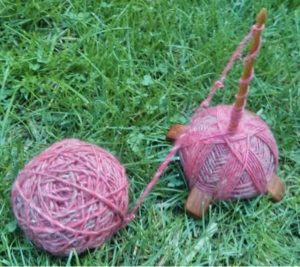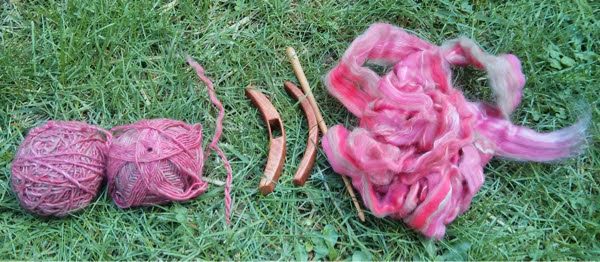Let’s face it. Comfort spinning is a thing. So I turn to my wall of tubs – 42 tubs stacked against the west wall of my bedroom, my entire stash and most of my spindles, all that remains after serious destashing and moving halfway across the United States during the first summer of Covid. I’m already planning what I want to spin – a nice squishy yarn. I want to enjoy every millimeter of it, so I turn to my spindle bins to pick out a few suitable for the yarn I can already picture. I want loft, so it’s going to be a 2-ply with thick low-twist singles. This will let the singles really puff out in the plying, and the final yarn will be a soft knitting yarn all squishy, puffy, lofty loveliness. I can almost picture the cowl I’d like to crochet from it…
Here’s the lineup: A Dealgan, a Portuguese spindle, and a Turkish with long arms for the plying. The Dealgan and Portuguese spindles are what I like to call “twiddle” spindles – they work by being twiddled in your fingers, though with a half-hitch you can also twirl them. Their larger shafts mean they don’t spin for long, but they have good weight so will spin even if I’m spinning a thicker single.
Now I turn to the fiber tubs. I have some gorgeous Merino/silk roving blends in my stash that I’ve been wanting to spin. The roving is full of air and will give me a woolen-spun yarn full of air as well. The hardest part is choosing between the beautiful turquoise or the amazing red-yellow “dragon fire.” I want to be warm, so dragon fire it is.
I can fill up the Dealgan first, carrying it with me as I move around the house, and spinning as I wait for the tea kettle to boil, while I chat on the phone to friends, during the walk out to the barn to tend my parents’ horses. The slow spin means I’ll want to draft thicker to get a stable single easily, which suits my goal yarn well. I’ll ply it back regularly at the start to check the plying twist; once I have that firmly in mind I will keep going, filling the spindle with that soft, thick single that plies back to a soft knitting yarn.
Once that’s full, I turn to the Portuguese spindle. It’s a little longer than the Dealgan, with a pointed far end; this one I can twirl with my fingers while the end rests on my leg. I happily pull it onto my lap after dinner with my parents as we chat by the fire; getting them to share stories of their childhoods has been so enlightening. My mother spent nights in an Anderson shelter during London’s WWII bombing raids! The Portuguese spindle is a slow spindle, so it also loves to spin those thick low-twist singles.
Once both are done, I wind the two spindlefuls together into a single, two-strand ball and ply them together onto the Turkish. If I’ve done a good job with the singles, and split the fiber between the two spindles evenly, they’ll come out close to the same length; I can usually fold the longer one back on itself into the ball or, if it’s too long, break it off and ply it separately to use for skein ties. Plying the two-strand ball is a fast task, since not much twist is needed for the balanced 2-ply squishy goodness I’m aiming for. I picked the longest-armed Turkish spindle I have (an Egret by Jenkins) because it will hold a lot of yarn. This lets me ply long lengths with each twirl of the spindle. And I can use the hand-rolling technique to really speed through the plying (see “Continuous Plying: The Power Play” in the Summer 2021 issue of PLY).
The glee I get whenever I deconstruct a Turkish spindle to free the ball of yarn definitely ups my comfort meter as the spinning wraps up. Watching the ball jump around the room as I skein it up is a hoot, though my dog doesn’t know what to make of it so he jumps out of its way a few times. The skein gets a nice soak in warm soapy water and a rinse in warm water. I like to dry my skeins by squeezing out the water, rolling the skein in a towel and pressing out the water, and then laying the skein out to dry on a towel – not hanging. I find countertop drying gives it a little extra bounce, and that’s definitely my goal here.
The spindles are returned to their nests, sharing stories of their most recent adventures with their buddies in my bentwood spindle box.
As the skein dries, I daydream crochet stitch patterns for something that strikes my fancy for the cowl. Maybe a fan stitch – this thick, squishy single will keep me warm even with a lacy stitch. If I start with a round of double crochets to frame the stitches, I can decide if I want to end with that too or leave it just a fan stitch on the last row of the cowl. Time to go hunt up a hook and get to work!
 This spinning tale brought to you by Amelia Read Garripoli, a recent returnee to her childhood home of Colorado. She now spins and weaves a mile and more above sea level, with her stash by her side. Amelia’s blog askthebellwether.com holds her past spinning wisdom, as do her articles in PLY and Spin-Off, her book Productive Spindling, and her videos on Turkish spindling and supported spindles. You can find her teaching on Zoom for HansenCrafts and guilds – she’s loving reaching any time zone, any place, to share her glee with all types of spinning: spindle, e-spinner, and wheel!
This spinning tale brought to you by Amelia Read Garripoli, a recent returnee to her childhood home of Colorado. She now spins and weaves a mile and more above sea level, with her stash by her side. Amelia’s blog askthebellwether.com holds her past spinning wisdom, as do her articles in PLY and Spin-Off, her book Productive Spindling, and her videos on Turkish spindling and supported spindles. You can find her teaching on Zoom for HansenCrafts and guilds – she’s loving reaching any time zone, any place, to share her glee with all types of spinning: spindle, e-spinner, and wheel!





Leave a Reply
Want to join the discussion?Feel free to contribute!